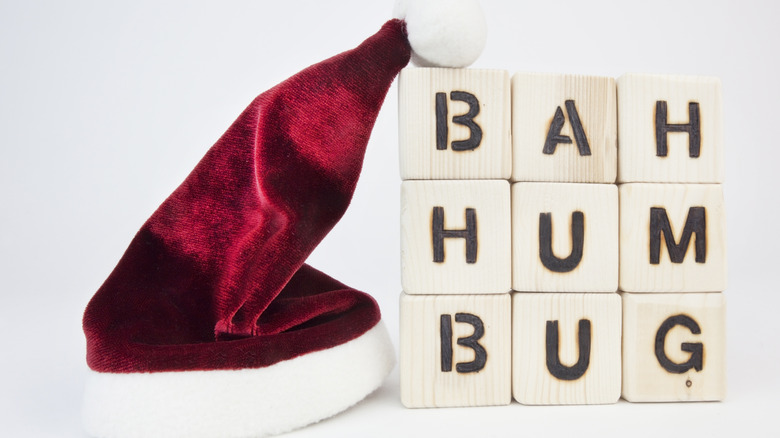What Does The Phrase 'Bah, Humbug' Really Mean?
"Bah, humbug" were the words famously uttered by Ebenezer Scrooge in Charles Dickens' "A Christmas Carol," which was published in 1843. Scrooge had a dislike for the Christmas holiday, and when his nephew wished him a merry Christmas, he simply replied, "Bah! Humbug!" Today, the phrase is used to convey displeasure, but it has a deeper meaning than that. In fact, when Scrooge said it, he was more than just disgruntled with the holiday. "What reason have you to be merry? You're poor enough," Scrooge told his nephew. He also told his clerk that Christmas is "a poor excuse for picking a man's pocket every twenty-fifth of December" (via Shmoop).
The Oxford Learner's Dictionaries defines the word humbug as "dishonest language or behavior that is intended to trick people." So, when Scrooge said the words, "bah, humbug," he was expressing his belief that Christmas was a sham holiday that was meant to deceive people. "Bah," on the other hand, is simply an exclamation of annoyance. Although the word is rarely used today, it was common even before Dickens used it in his novel.
Other uses of the word
The word "humbug" was also popular in the field of medicine. In 1846, surgeon John Collins Warren performed the very first public demonstration of a patient undergoing surgery using sulfuric ether as a form of anesthesia. Back then, it was common for surgeons to operate on patients without anesthesia, so Warren's successful procedure astounded his audience. He supposedly uttered the words, "Gentlemen! This is no humbug," after completing the procedure, as reported by Hektoen International.
Famous showman P.T. Barnum reportedly loved the word "humbug" and interpreted it in his own way. Throughout his career, Barnum was accused of carrying out humbugs to fool people who attended his attractions. One of his famous hoaxes was a creature he claimed was a mermaid, but in reality, it was just the top half of a monkey and the tail of a fish sewn together, per Live Science. While some people accused Barnum of being a swindler who profited from his humbugs, he believed otherwise. His belief was that he wasn't a swindler as his humbugs had the goal to entertain, while swindlers left their victims feeling cheated (via CNN).
Humbug also appeared in yet another popular literary piece: "The Wizard of Oz." One of the chapters of the book is titled "The Magic Art of the Great Humbug," and it's where Dorothy and her companions discover that the Wizard of Oz wasn't a wizard at all, and the young girl referred to him as "the great and terrible humbug" (via Online Literature).

